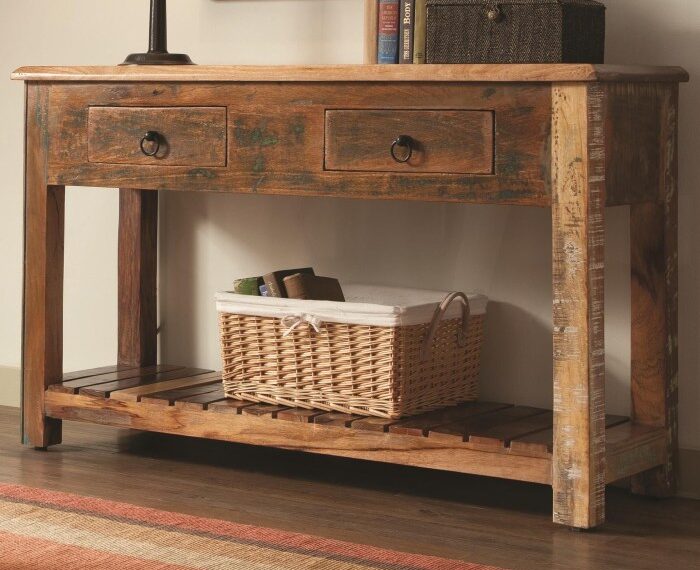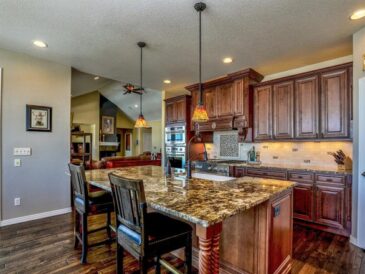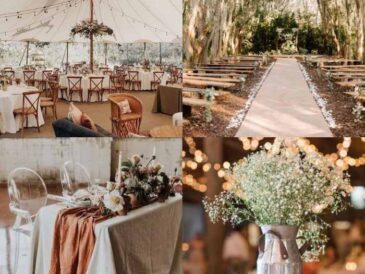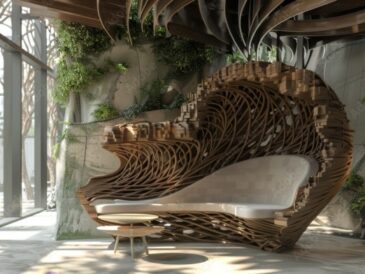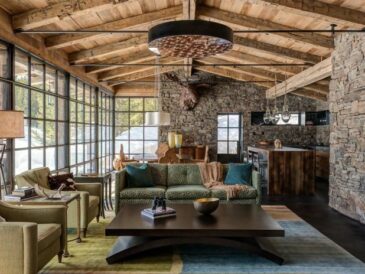Console table rustic decor blends the timeless elegance of a console table with the warmth and character of rustic design. This unique combination creates a focal point that instantly adds charm and sophistication to any space, seamlessly integrating with various interior styles.
From its practical functionality as an entryway organizer to its ability to enhance the visual appeal of a living room or dining area, a rustic console table offers a versatile solution for both style and storage. Its rugged charm, often achieved through the use of natural wood, distressed finishes, and rustic accents, complements a wide range of design preferences, creating a welcoming and inviting atmosphere.
Rustic Decor Style
Rustic decor evokes a sense of warmth, comfort, and connection to nature. It often incorporates natural elements, weathered textures, and a relaxed, unpretentious aesthetic. This style celebrates the beauty of imperfections and embraces the patina of time.
Incorporating Rustic Elements into Furniture Design
Rustic elements are seamlessly integrated into furniture design, creating pieces that are both visually appealing and functional. These elements add character and depth to furniture, making each piece unique.
- Distressed Finishes:Rustic furniture often features distressed finishes, which are achieved through techniques like sanding, chipping, or painting. These finishes create a weathered look that adds character and a sense of history.
- Natural Wood Textures:The use of natural wood with its unique knots, grains, and color variations is a hallmark of rustic decor. These textures bring warmth and authenticity to furniture.
- Reclaimed Materials:Incorporating reclaimed materials like old barn wood, salvaged beams, or repurposed furniture adds a story and a touch of history to rustic furniture.
- Rustic Hardware:Simple, functional hardware made from materials like iron, copper, or brass adds a touch of authenticity and complements the rustic aesthetic.
Common Rustic Materials for Console Tables
Rustic console tables are often crafted from materials that embody the spirit of nature and the charm of the past. These materials are durable, long-lasting, and contribute to the overall rustic aesthetic.
- Reclaimed Wood:Reclaimed wood, such as old barn wood or salvaged beams, adds character and a touch of history to rustic console tables. These materials often have unique knots, grains, and color variations that create a one-of-a-kind piece.
- Rough-Hewn Timber:Rough-hewn timber, which is wood that has been minimally processed, retains its natural texture and imperfections. This adds a rustic charm to console tables and complements the overall aesthetic.
- Stone:Natural stone, like granite or slate, can be used to create rustic console tables that are both durable and elegant. Stone adds a sense of weight and permanence to the piece.
- Metal:Metal, such as wrought iron or distressed steel, can be incorporated into rustic console tables to add a touch of industrial charm. Metal accents can be used for legs, frames, or hardware.
Rustic Console Table Design Elements
Rustic console tables are known for their unique blend of natural beauty and handcrafted charm. Their design elements often reflect a connection to nature, incorporating raw materials and traditional techniques.
Wood Types
The choice of wood is crucial in defining the rustic aesthetic. Rustic console tables frequently feature wood types known for their durability, distinctive grain patterns, and natural variations.
- Reclaimed Wood:This type of wood is salvaged from old buildings, barns, or other structures. It often carries the marks of time, including knots, cracks, and color variations, adding to its character and rustic charm. Reclaimed wood is a sustainable choice, contributing to environmental conservation.
- Oak:Known for its strength and rich grain, oak is a popular choice for rustic furniture. Its warm tones and natural variations contribute to a timeless and classic look. Oak is also durable and can withstand heavy use.
- Pine:Pine is a softwood that adds a light and airy feel to rustic decor. Its knots and grain patterns create a visually appealing texture, and its affordability makes it a popular choice for rustic console tables.
- Walnut:Walnut wood is prized for its rich, dark color and distinctive grain pattern. It often features swirls and streaks, adding a touch of elegance to rustic console tables.
Finishes
Rustic console tables often feature finishes that enhance the natural beauty of the wood while adding a touch of character.
- Natural Oil Finish:This finish allows the wood’s grain and color to shine through while providing a protective layer. It’s a popular choice for rustic furniture as it enhances the natural beauty of the wood.
- Wax Finish:Wax finishes provide a subtle sheen and a protective layer that enhances the wood’s natural texture. They’re easy to apply and maintain, making them a practical choice for rustic console tables.
- Distressed Finish:Distressing techniques create a weathered and aged look, enhancing the rustic charm of the console table. These techniques can involve sanding, chipping, or applying paint to create the appearance of age and wear.
Hardware
The hardware used on rustic console tables often complements the natural elements of the design.
- Iron Hardware:Iron hardware, such as hinges, handles, and drawer pulls, adds a touch of rustic charm and durability. It complements the natural warmth of wood and often features a distressed or blackened finish.
- Brass Hardware:Brass hardware adds a touch of elegance and warmth to rustic console tables. It often features a brushed or antique finish, complementing the natural tones of the wood.
Distressing and Aging Techniques
Distressing and aging techniques are essential in achieving the rustic aesthetic. These techniques create the appearance of time and use, adding a layer of character and authenticity to rustic console tables.
- Sanding:Sanding techniques can be used to create a distressed look by removing layers of paint or stain, revealing the wood’s natural texture and color variations.
- Chipping:Chipping techniques can be used to create the appearance of wear and tear, adding a touch of authenticity to the rustic design. This can be achieved by using a hammer or other tools to create small chips in the wood’s surface.
- Paint:Paint can be used to create a distressed look by applying layers of paint and then sanding or chipping them away to reveal the wood beneath. This technique creates a layered effect that adds depth and character.
Placement and Functionality: Console Table Rustic Decor
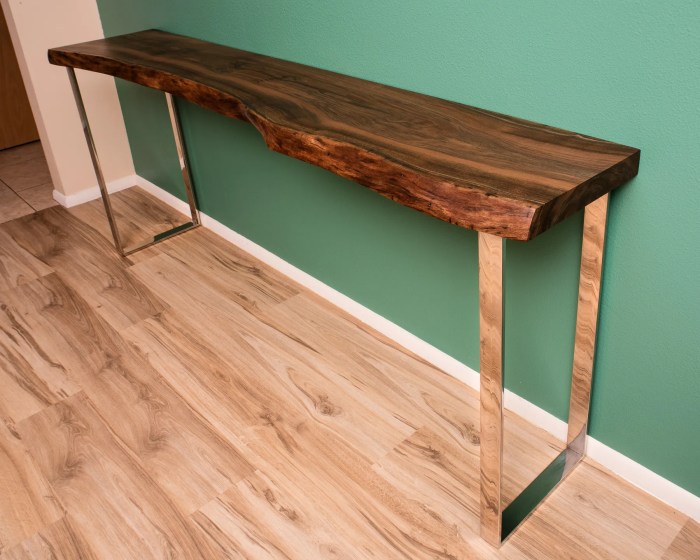
A console table, with its versatile design and functionality, can significantly enhance the ambiance and utility of a rustic living room. It’s a piece that seamlessly blends form and function, offering a practical surface for display and storage while adding a touch of rustic charm to your space.
Console Table Placement in a Rustic Living Room
The placement of a console table in a rustic living room plays a crucial role in defining the flow and functionality of the space.
- Behind the Sofa:A console table placed behind the sofa creates a visual focal point and provides a practical surface for lamps, books, and decorative items. The rustic elements of the table, like reclaimed wood or metal accents, will complement the overall theme of the room.
- In a Corner:A console table nestled in a corner can effectively fill a vacant space and provide a dedicated area for displaying treasured items. Choose a table with a smaller footprint to avoid overwhelming the corner. A rustic console table with a distressed finish will add a touch of warmth and character to the corner.
- In an Entryway:A console table placed in the entryway serves as a welcoming element and provides a practical surface for keys, mail, and other essentials. A console table with a rustic design, such as a reclaimed wood top or wrought iron legs, will create a welcoming and inviting atmosphere.
Choosing the Ideal Size and Placement
Selecting the right size and placement for a console table is essential to ensure it complements the existing furniture and layout of the room.
- Measure the Space:Before purchasing a console table, carefully measure the space where you plan to place it. Consider the dimensions of the table, including its height, width, and depth, to ensure it fits comfortably without obstructing the flow of traffic.
- Consider the Scale:Choose a console table that is proportionate to the size of the room and the other furniture pieces. A large console table may overwhelm a small space, while a small console table may look lost in a large room.
- Think About Functionality:Determine the primary purpose of the console table and select a size that meets your needs. If you plan to use it for storage, choose a table with drawers or shelves. If you plan to use it for display, choose a table with a large surface area.
Enhancing Functionality
A console table is more than just a decorative piece; it can be a functional addition to your rustic living room.
- Storage Solutions:Console tables with drawers, shelves, or baskets offer valuable storage space for books, magazines, remote controls, or other items. Choose a table with storage features that best suit your needs and the layout of your living room.
- Display Area:The surface of a console table provides an ideal space for displaying decorative items, such as vases, plants, artwork, or family photos. These items can add personality and visual interest to the room.
- Additional Seating:Some console tables have a built-in bench or seating area, which can be used for extra seating or as a place to put on shoes. This functionality is especially useful in a small living room or entryway.
Materials and Construction
Rustic console tables are crafted from a variety of natural materials, primarily wood. The choice of wood significantly influences the table’s aesthetic, durability, and overall character. The construction process involves careful selection, preparation, and assembly techniques that highlight the wood’s natural beauty while ensuring structural integrity.
Types of Wood Used
The type of wood used for a rustic console table significantly impacts its appearance, durability, and overall character. Here are some common choices:
- Reclaimed Wood:Reclaimed wood, salvaged from old barns, sheds, or other structures, adds a unique history and character to a console table. Its weathered and distressed appearance creates a rustic charm, and it often features knots, imperfections, and variations in color.
A console table in rustic decor can instantly elevate your entryway or living room. The warm, natural tones and textures of rustic furniture create a welcoming and inviting atmosphere. To achieve a truly rustic look, consider incorporating elements from cheap rustic home decor like reclaimed wood accents, vintage metal pieces, and woven baskets.
These budget-friendly additions will complement your console table and complete the rustic aesthetic.
Popular reclaimed wood options include barnwood, oak, pine, and cedar.
- Rustic Pine:Pine is a softwood known for its affordability and natural beauty. Its knots and grain patterns contribute to a rustic aesthetic. Pine is commonly used for console tables, as it can be easily worked and finished.
- Oak:Oak is a hardwood known for its strength, durability, and distinctive grain patterns. It adds a classic and elegant touch to rustic console tables. Oak is a popular choice for furniture because it ages gracefully and develops a rich patina over time.
- Cedar:Cedar is a fragrant and naturally insect-resistant wood. Its reddish-brown hue and distinctive grain patterns add a warm and inviting feel to console tables. Cedar is often used for outdoor furniture due to its durability and weather resistance.
Crafting a Rustic Console Table
Crafting a rustic console table from scratch involves several steps, including:
- Design and Planning:Begin by sketching out the design of the console table, considering its dimensions, shape, and features. Determine the type of wood, the desired finish, and any additional embellishments.
- Wood Selection and Preparation:Choose the wood based on the desired aesthetic and durability. Prepare the wood by cutting it to size, sanding it smooth, and applying any necessary treatments to prevent warping or cracking.
- Assembly:Join the individual pieces of wood using traditional woodworking techniques like mortise and tenon joints, dovetail joints, or glue and screws. These techniques ensure the table’s stability and durability.
- Finishing:Apply a suitable finish to protect the wood and enhance its natural beauty. This could include staining, painting, or applying a clear sealant. The choice of finish depends on the desired aesthetic and the wood’s properties.
Durability and Maintenance
Rustic console tables crafted from durable wood, such as oak or reclaimed hardwoods, can last for generations with proper care. However, certain aspects of their construction and materials require specific maintenance practices:
- Wood Movement:Rustic wood is prone to expansion and contraction due to changes in humidity and temperature. This movement can cause gaps or cracks to appear in the table’s structure. To minimize this, use wood that has been properly dried and acclimated to the environment.
It’s also important to avoid placing the table in direct sunlight or near heat sources.
- Finish Maintenance:The finish applied to the table protects the wood from moisture, scratches, and stains. Regularly dust and clean the table with a soft cloth. For deeper cleaning, use a mild soap and water solution. Avoid using harsh chemicals or abrasive cleaners that can damage the finish.
- Hardware:Rustic console tables often feature hardware like hinges, drawer pulls, and legs. Ensure these components are made of durable materials and are properly installed to prevent wear and tear. Inspect the hardware periodically for signs of rust or damage and replace as needed.
Decorating a Rustic Console Table
A rustic console table provides a charming focal point in any room, offering a blend of natural beauty and functional storage. Its unique character can be enhanced with carefully chosen decorative elements that complement its rustic aesthetic.
Decorative Elements for a Rustic Console Table
Decorating a rustic console table involves selecting elements that enhance its natural charm and create a cohesive design. These elements can range from natural materials to vintage finds, adding a touch of warmth and character to the space.
- Natural Elements:Incorporating natural elements like wood, stone, or metal adds a rustic touch. Consider a wooden bowl filled with pinecones, a stone sculpture, or a metal lantern. These elements bring a sense of the outdoors indoors, creating a cozy and inviting atmosphere.
- Vintage Finds:Vintage items, such as old books, antique clocks, or rustic picture frames, add character and history to the table. These pieces often have unique imperfections that enhance the rustic aesthetic. A vintage map displayed in a distressed frame can also create a focal point.
- Textiles:Rustic textiles like burlap, linen, or wool add warmth and texture. A burlap runner can be placed on the table, and a vintage-inspired throw blanket draped over a chair can create a cozy ambiance.
- Plants:Adding greenery is essential for a rustic console table. A potted succulent, a small fern, or a vase filled with wildflowers can add life and freshness to the space.
Visual Display Ideas
A visually appealing display on a rustic console table involves balancing different elements to create a cohesive and inviting arrangement.
- Layered Arrangement:Start by placing a large, rustic item, such as a wooden bowl or a vintage lamp, as the base of the display. Layer smaller items like a vase of flowers, a framed photograph, or a stack of books on top.
- Height Variation:Create visual interest by incorporating items of varying heights. Place a tall lamp on one end of the table and a small sculpture or a stack of books on the other end.
- Symmetry and Asymmetry:Consider using symmetry or asymmetry in your arrangement. A symmetrical display can create a sense of balance, while an asymmetrical display can add visual interest.
- Color Palette:Stick to a limited color palette to maintain a cohesive look. Earthy tones like browns, greens, and creams are ideal for a rustic console table.
Rustic-Themed Accessories and Decor
A variety of rustic-themed accessories and decor can enhance the charm of a console table.
- Rustic Lamps:A wooden lamp with a burlap shade or a metal lantern with a flickering candle adds a touch of warmth and charm to the table.
- Wooden Trays:A wooden tray can be used to organize items like candles, coasters, or remotes.
- Rustic Mirrors:A rustic mirror can add depth and light to the space. Look for mirrors with distressed frames or reclaimed wood accents.
- Rustic Artwork:Framed photographs of nature scenes, vintage maps, or rustic prints can add a touch of personality to the table.
Styles and Variations
Rustic console tables come in a variety of styles, each with its own unique characteristics. Understanding these styles allows you to choose the perfect console table for your home and design aesthetic.
Rustic Farmhouse Style
Rustic farmhouse console tables are characterized by their simple, functional design and use of natural materials. They often feature distressed wood finishes, exposed beams, and metal accents. These tables exude a warm, inviting atmosphere, reminiscent of a cozy farmhouse.
Industrial Style
Industrial-style console tables incorporate elements of industrial design, such as exposed metal, reclaimed wood, and a minimalist aesthetic. They often have a sleek, modern feel with a touch of rustic charm. These tables are perfect for adding a touch of urban chic to any space.
Modern Rustic Style
Modern rustic console tables blend rustic elements with modern design principles. They typically feature clean lines, simple shapes, and a focus on natural materials. These tables are perfect for those who want a rustic feel with a contemporary edge.
Coastal Rustic Style
Coastal rustic console tables combine rustic elements with coastal influences. They often feature weathered wood, rope accents, and a light, airy feel. These tables are ideal for creating a relaxed, beachy vibe in your home.
Transitional Rustic Style
Transitional rustic console tables bridge the gap between traditional and contemporary styles. They feature a blend of rustic elements, such as distressed wood and metal accents, with more refined details and a sophisticated aesthetic. These tables are perfect for creating a timeless and elegant look.
Finding the Perfect Rustic Console Table
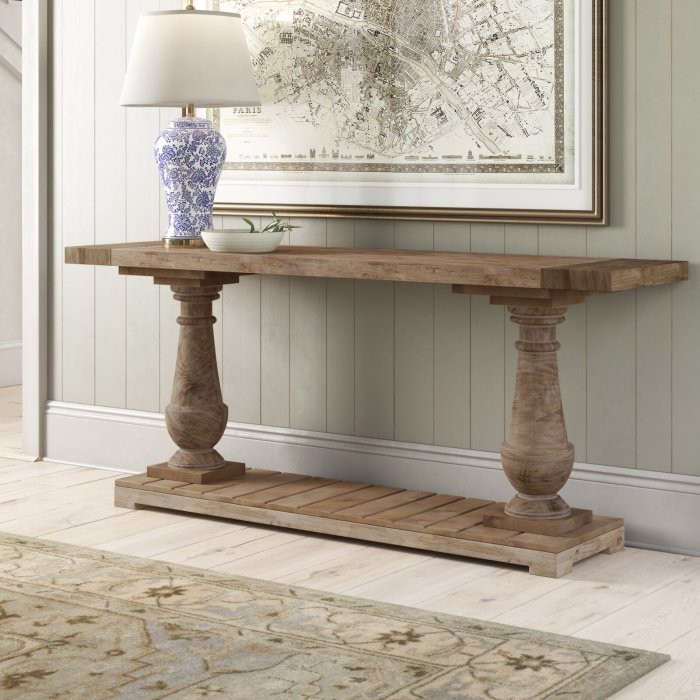
Finding the perfect rustic console table involves careful consideration of various factors. It’s not just about finding a piece that fits your space; it’s about finding a piece that reflects your style, complements your existing decor, and serves a practical purpose.
Factors to Consider When Selecting a Rustic Console Table
Choosing the right rustic console table requires thoughtful consideration of several key factors. This checklist will guide you in making an informed decision that aligns with your preferences and needs.
- Size and Shape: The console table should be proportionate to the space where it will be placed. Consider the width, depth, and height of the table, ensuring it doesn’t overwhelm the room or create a cramped feeling. The shape of the table can also affect the overall look of the space, with rectangular tables offering a more traditional feel and rounded tables providing a softer, more contemporary touch.
- Style: Rustic console tables come in a wide range of styles, from farmhouse to industrial to reclaimed wood. Choose a style that complements your existing decor and personal taste.
- Material: Rustic console tables are often made from natural materials such as wood, metal, or a combination of both. Consider the durability, maintenance requirements, and aesthetic appeal of each material.
- Finish: The finish of a rustic console table can significantly impact its overall look. Consider the color, texture, and sheen of the finish, choosing a finish that complements your existing decor and personal preferences.
- Storage and Functionality: Assess your storage needs. Some console tables offer drawers, shelves, or other storage options. Determine if you need additional storage and choose a table that meets those requirements.
- Budget: Set a budget before you start shopping. Rustic console tables can range in price depending on their size, material, and craftsmanship.
Tips for Finding a Console Table That Complements Existing Rustic Decor
Finding a rustic console table that seamlessly blends with your existing decor is crucial for achieving a cohesive and visually appealing space. Here are some tips to help you find the perfect match.
- Color Palette: Consider the dominant colors in your existing rustic decor. Choose a console table that features similar or complementary colors to create a unified look. For instance, if your decor features warm tones of brown and beige, look for a console table with a similar color palette.
- Texture and Material: Pay attention to the texture and material of your existing rustic decor. Look for a console table that complements those elements. If your decor features a lot of natural wood, consider a console table made from reclaimed wood or distressed wood.
A console table with rustic decor can add a touch of warmth and charm to any entryway or living room. If you’re looking to achieve this look without breaking the bank, consider some cheap DIY rustic decor ideas. Repurposing old wood, adding distressed finishes, and incorporating natural elements like branches or stones can create a stunning and budget-friendly console table display.
- Style Consistency: Ensure the style of the console table aligns with your existing rustic decor. For example, if your decor leans towards a farmhouse aesthetic, choose a console table with a farmhouse-inspired design.
- Accessorize Strategically: Use accessories to bridge the gap between your console table and existing decor. For instance, if your console table has a more modern design, add rustic elements like a woven basket or a vintage vase to create a cohesive look.
Quality and Craftsmanship in Rustic Furniture
Quality and craftsmanship are paramount in rustic furniture, as they contribute to its longevity, durability, and aesthetic appeal. Here’s why these aspects are essential:
- Durability: High-quality rustic furniture is built to last, with sturdy construction and materials that can withstand everyday use.
- Aesthetic Appeal: Craftsmanship is evident in the details, from the smooth finish to the intricate joinery. Well-crafted rustic furniture possesses a timeless beauty that enhances the overall aesthetic of your space.
- Value: Investing in quality rustic furniture is a worthwhile investment, as it retains its value over time.
DIY Rustic Console Table Project
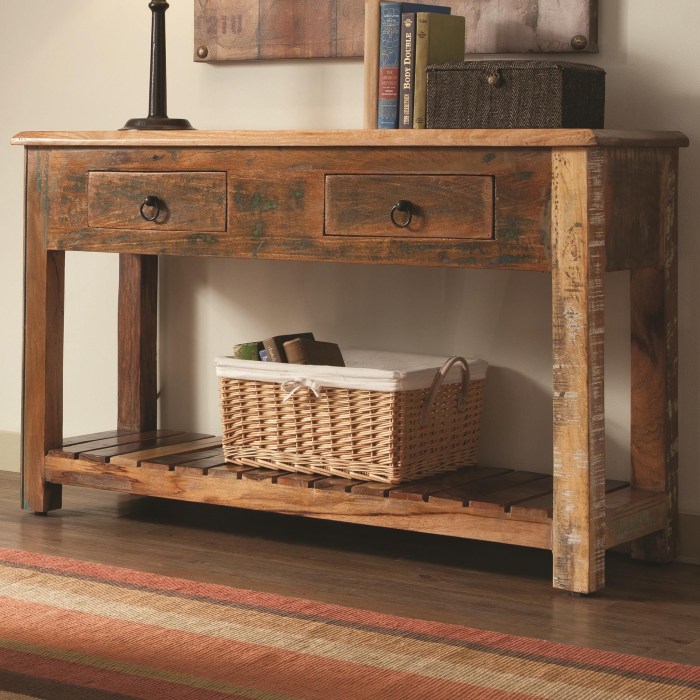
Building a rustic console table is a rewarding DIY project that allows you to create a unique piece of furniture that reflects your personal style. This project is relatively simple and can be completed with basic woodworking skills and tools.
Materials and Tools
The materials and tools needed for this project are readily available at most hardware stores and online retailers. You’ll need to gather the following:
- Wood: Two 1×6 boards for the top, two 1×4 boards for the legs, and one 1×2 board for the shelf (adjust lengths based on your desired table dimensions)
- Wood glue
- Wood screws
- Finishing nails
- Wood stain (optional)
- Polyurethane (optional)
- Measuring tape
- Saw (circular saw, jigsaw, or handsaw)
- Drill with drill bits
- Screwdriver
- Sandpaper (various grits)
- Clamps
- Level
Cutting and Assembling the Table Top, Console table rustic decor
The table top is made of two 1×6 boards. Begin by cutting the boards to your desired length. For a standard console table, a length of 48 inches is typical.
- Measure and mark the boards to the desired length.
- Use a saw to cut the boards to the marked length. Make sure the cuts are straight and even.
- Sand the edges of the boards to smooth out any rough spots.
- Apply wood glue to the edges of the boards that will be joined together.
- Clamp the boards together and let the glue dry completely.
Creating the Legs
The legs of the console table are made from two 1×4 boards.
- Measure and mark the boards to the desired height. A standard height for a console table is 30 inches.
- Cut the boards to the marked height using a saw.
- Sand the edges of the boards to smooth out any rough spots.
Attaching the Legs to the Table Top
Once the legs are cut, you can attach them to the table top.
- Position the legs at the corners of the table top, making sure they are evenly spaced and aligned.
- Pre-drill pilot holes into the table top and legs to prevent splitting the wood.
- Use wood screws to attach the legs to the table top.
- Use a level to ensure the legs are plumb and the table top is level.
Adding a Shelf
To create a shelf, you can use a 1×2 board.
- Cut the board to the desired length and width to fit inside the table frame.
- Sand the edges of the board to smooth out any rough spots.
- Attach the shelf to the legs using wood screws or finishing nails. Make sure the shelf is level.
Finishing Touches
Once the table is assembled, you can add some finishing touches to give it a rustic look.
- Sand the entire table with sandpaper to smooth out any rough spots and create a more uniform surface.
- Apply a wood stain to the table if desired. Choose a stain color that complements your décor.
- Apply a coat of polyurethane to the table to protect it from scratches and water damage.
- To achieve a distressed look, you can use sandpaper to lightly sand off some of the stain or polyurethane in areas that will naturally see more wear and tear, such as the edges and corners.
Tips for Achieving a Rustic Finish
Here are some tips for achieving a rustic finish:
- Use reclaimed or salvaged wood. Reclaimed wood often has unique knots, imperfections, and color variations that add to its rustic charm.
- Use a dark stain or paint. Darker colors enhance the natural wood grain and create a more aged look.
- Distress the wood. Sanding, chipping, and hammering the wood can create a weathered and rustic look.
- Add hardware with a rustic finish. Look for hardware with a distressed metal or antique finish.
Safety Precautions
Always wear safety glasses and ear protection when using power tools.
Final Summary
Whether you’re seeking to enhance the functionality of your entryway, create a cozy focal point in your living room, or simply add a touch of rustic charm to your home, a console table provides a versatile and stylish solution. With its natural beauty, durability, and adaptability, a rustic console table is a timeless piece that will continue to enhance your home for years to come.
Detailed FAQs
What are some popular rustic console table materials?
Reclaimed wood, pine, oak, and cedar are commonly used for rustic console tables. These woods often feature knots, grain patterns, and natural imperfections that enhance the rustic aesthetic.
How do I style a rustic console table?
Incorporate elements like weathered wood baskets, rustic lamps, vintage mirrors, and natural greenery to complement the table’s rustic charm. Consider adding a touch of personality with family photos, travel souvenirs, or antique books.
Where can I find a rustic console table?
You can find rustic console tables at furniture stores, online retailers, and even antique shops. Consider searching for local artisans who specialize in handcrafted rustic furniture.

